RD’s intervention for the special session on the health conditions in the occupied Palestinian territory, including east Jerusalem Geneva
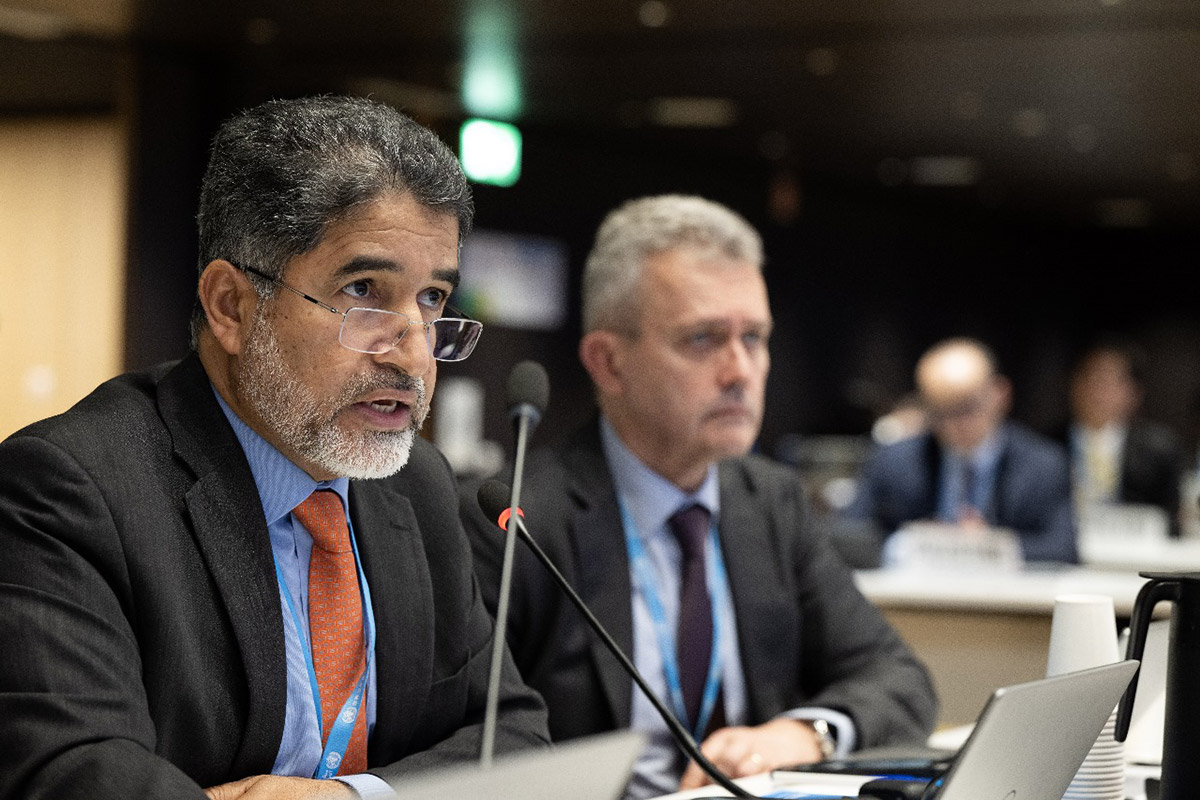
Geneva, 10 December 2023
Dear colleagues, ladies, and gentlemen,
I would like to start by asking for a minute of silence in memory of our WHO colleague Dima Alhaj and all the humanitarian workers who have been killed in Gaza, some with several of their family members, over the past two months.
WHO’s Eastern Mediterranean Region – plagued by some of the world’s worst humanitarian emergencies – is home to almost 40% of all people in need of aid globally. People in our Region, the majority women and children, are some of the most vulnerable in the world, with too many deprived of their most basic human rights.
The escalating hostilities in Israel and the occupied Palestinian territory have unleashed a profound humanitarian crisis.
As the bombardments continue, our team in Gaza says that hospital emergency departments look like battlefields, packed with people suffering from war wounds – including children with severe burns – and the floors covered in blood. Many people are dying of their injuries before they are even able to find a hospital that has the capacity or resources to save them.
Cases of infectious diseases are rapidly spreading, and people are on the brink of starvation, with reports of some households going for up to 24 hours without food or water.
Beyond the urgent need to end this horrific suffering, our Region may not be able to withstand further threats to its health security.
Countries affected by the spillover of hostilities, including Iraq, Lebanon, Syria, and Yemen, are already struggling to keep their health systems afloat and suffer from poor infrastructure and limited health resources. They cannot afford to be further challenged.
We are concerned about escalating hostilities in the West Bank, as well as in southern Lebanon near the border with Israel, which are leading to even more loss of life, injury, displacement, and damages to health infrastructure.
The current catastrophic situation – if not immediately halted – has the potential to further destabilize public health and place countless more lives at risk.
Only an immediate ceasefire can ultimately stop the suffering and prevent the health security of the entire Region from further spiraling downward.
المنظمة تفقد الاتصال بمستشفى الشفاء في غزة وسط تقارير عن تعرضه لهجمات
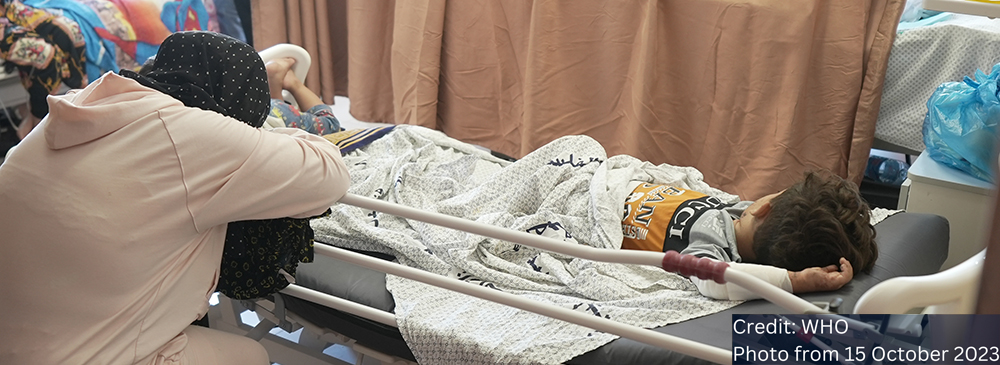 العديد من الجرحى يتلقون الرعاية في مستشفى الشفاء بغزة منذ أوائل أكتوبر 2023. الصورة من 15 أكتوبر 2023. (صورة خاصة بمنظمة الصحة العالمية)
العديد من الجرحى يتلقون الرعاية في مستشفى الشفاء بغزة منذ أوائل أكتوبر 2023. الصورة من 15 أكتوبر 2023. (صورة خاصة بمنظمة الصحة العالمية)
12 تشرين الثاني/ نوفمبر 2023 - فقدت المنظمة الاتصال مع مستشفى الشفاء في شمال غزة. ومع تواصل التقارير المروعة عن تكرار تعرض المستشفى لهجمات، نفترض أن مَن كنا نتواصل معهم يلحقون الآن بعشرات الآلاف من النازحين الذين كانوا قد اتخذوا من المستشفى ملجأ ولكنهم يهربون الآن من المنطقة. وقد وردت تقارير تفيد بأن بعض مَن فروا من المستشفى تعرضوا لإطلاق النار عليهم وجرحوا، بل وقُتل بعضهم.
وعلى مدى آخر 48 ساعة، وردت تقارير بتكرار تعرض مستشفى الشفاء لهجمات أسفرت عن مقتل عدة أشخاص وجرح الكثيرين غيرهم. وتعرضت وحدة العناية المركزة لتلفيات من جراء القصف، كما حدثت تلفيات أيضًا في بعض أماكن من المستشفى كان النازحون يحتمون بها. كما وردت تقارير بأن مريضًا متصلًا بأنبوب تنفس قد تُوفي نتيجة قطع الكهرباء لبعض الوقت.
ووفقًا لآخر تقارير، فإن المستشفى محاط بالدبابات، كما ذكر طاقم المستشفى عدم توافر المياه النظيفة ووجود خطر لتوقف آخر الخدمات الحيوية التي كانت مستمرة، ومنها وحدات العناية المركزة وأجهزة التنفس الصناعي والحضَّانات، عن العمل بسبب نقص الوقود. وإذا حدث ذلك، فستتعرض حياة المرضى لخطر داهم.
وتعرب المنظمة عن قلقها البالغ إزاء سلامة العاملين الصحيين ومئات المرضى والمصابين، بمن فيهم الأطفال في الحضّانات والنازحون الذين ما يزالون داخل مستشفى الشفاء، وهو أكبر مجمع طبي في غزة. ووفقًا لآخر تقارير، فإن عدد المرضى الداخليين يكاد يكون ضعف سعة المستشفى، برغم اقتصار الخدمات على الرعاية الطارئة اللازمة لإنقاذ الأرواح.
ولا ينبغي أبدًا أن يشعر المرضى الذين يلتمسون الرعاية الصحية بالخوف، ولا ينبغي أبدًا إجبار العاملين الصحيين الذين أقسموا على علاجهم على المخاطرة بحياتهم لتقديم الرعاية.
وتكرر المنظمة دعوتها إلى وقف فوري لإطلاق النار في غزة لأنه السبيل الوحيد لإنقاذ الأرواح ووضع حد للمعاناة المروعة هناك. فالمستشفيات والمرضى والطواقم الطبية والبشر الذين يحتمون في المرافق الصحية يتمتعون بالحماية بموجب اتفاقيات جنيف والقانون الإنساني الدولي.
وتدعو المنظمة أيضًا إلى إجراء عمليات إجلاء طبي مستمرة ومنظمة وآمنة بدون عوائق لأصحاب الحالات الحرجة من المرضى والجرحى إلى مصر عبر معبر رفح الحدودي، مع إمكانية نقلهم عند الحاجة من مصر إلى أماكن أخرى. كما ينبغي إطلاق سراح جميع الرهائن بدون قيد أو شرط، وأن يتلقوا الرعاية الطبية المناسبة أثناء وجودهم في الأسر.
وفي النهاية، لا بد من وضع القيم الإنسانية فوق كل اعتبار.
روابط ذات صلة
ارتفاع خطر انتشار الأمراض في غزة مع تعطل المرافق الصحية وشبكات المياه والصرف الصحي
منظمة الصحة العالمية: الهجمات على الرعاية الصحية في قطاع غزة غير مقبولة
منظمة الصحة العالمية ترحب بقرار مصر استقبال مرضى من قطاع غزة
نداء تمويل لعدة بلدان: الأرض الفلسطينية المحتلة ومصر ولبنان والجمهورية العربية السورية والأردن
إمدادات صحية من المنظمة تتحرك باتجاه غزة
بيان منظمة الصحة العالمية بشأن الهجوم على مستشفى الأهلي العربي والإصابات الكبيرة التي نتجت عنه
المنظمة تقدم إمدادات طبية إلى لبنان مع تصاعد العنف في الأرض الفلسطينية المحتلة
إمدادات منظمة الصحة العالمية الصحية المنقذة للحياة تصل إلى مصر لتلبية احتياجات السكان في غزة
أوامر إسرائيل بإخلاء المستشفيات في شمال غزة هي حكم بالإعدام على المرضى والمصابين
المنظمة تناشد إسرائيل إلغاء أوامر إخلاء غزة لحماية صحة سكانها والحد من معاناتهم
منظمة الصحة العالمية تحذر: المستشفيات في قطاع غزة على وشك الانهيار
Youth council
Picturing health
75 years of progress and challenges
This year, WHO celebrates its 75th anniversary. This exhibition looks back at some of the public health successes that have improved the quality of life over the past 7-plus decades and highlights future health challenges.
In 1951, WHO organized its first professional photographic mission. The WHO photography collection now holds more than 58 000 images – a vast visual record devoted to picturing health.

WHO’s home in Geneva, Switzerland
After 20 years at the Palais des Nations, WHO was given a plot of land in Pregny by the Swiss canton of Geneva. In 1966, WHO moved into its own building, designed by Jean Tschumi. The building is considered one of the masterpieces of contemporary Swiss architecture.

Regional Office opens in Alexandria, Egypt
The WHO Regional Office for the Eastern Mediterranean in Alexandria, Egypt. Established in 1949, the Regional Office was originally located in the old quarantine authority building, which was kindly made available by the Government of Egypt.

Annual meeting of WHO decision-making body
The inauguration of the 39th session of the WHO Regional Committee for the Eastern Mediterranean, at the Regional Office for the Eastern Mediterranean, Alexandria, Egypt, in October 1992. Held annually in each WHO region, the regional committees are where Member States decide on actions to realize health for all.

Leprosy eliminated in most countries by 2010
A doctor in Pakistan checks children for telltale signs of leprosy. By 2010, leprosy had been eliminated in most countries. More than 200,000 cases are still reported each year. Almost all these new cases are cured with multidrug therapy.
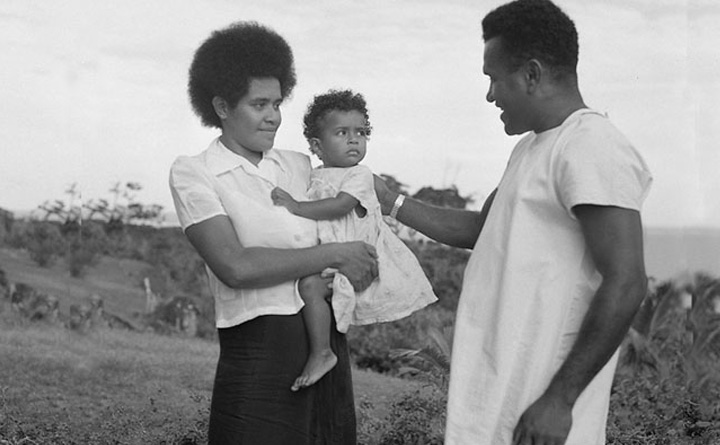
Focus on mass campaigns against infectious diseases
A yaws eradication team leader greets a mother and child in Namara, Fiji. In its first two decades, WHO had a strong focus on mass campaigns against infectious diseases, including yaws. This chronic disfiguring and debilitating childhood infectious disease can be cured with a single oral dose of an inexpensive antibiotic.

Measles and rubella elimination in the Eastern Mediterranean Region
Children in Egypt receive the measles–rubella vaccine. In November 2022, WHO’s Regional Verification Commission declared Egypt clear of measles and rubella for the period 2018–2021.
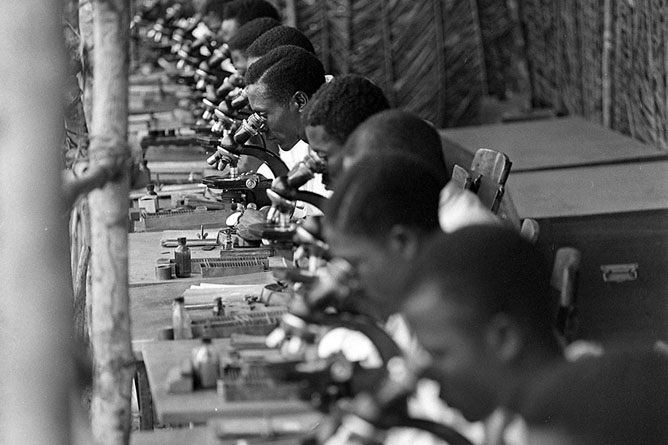
Sleeping sickness cases fall below 1000 in 2021
A sleep brigade looks for the parasite responsible for human African trypanosomiasis, also known as sleeping sickness. Without treatment, the disease can be fatal. Sustained control efforts have reduced the number of new infections. In 2009, the number dropped below 10,000 for the first time in 50 years. In 2021, only 802 cases were reported.
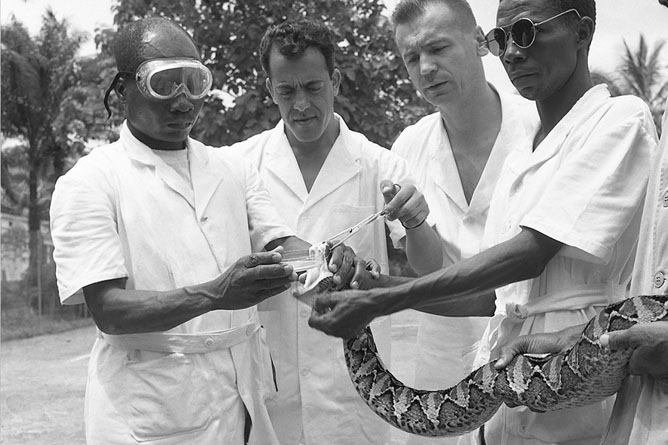
Improving access to antivenoms for snakebites
A team collects snake venom to create treatments for snakebites. Every year, more than 4.5 million people globally receive a snakebite, which may result in paralysis, kidney injury, permanent disability, or death. Where snakebite is endemic, WHO works to improve access to safe and effective treatments, educate communities to reduce risk, and improve training for health workers.
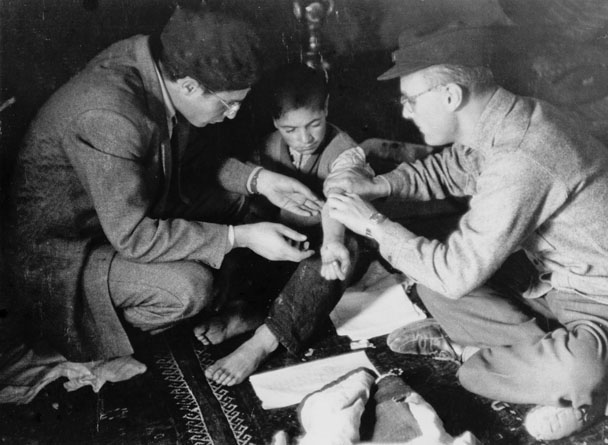
The road to zero malaria
In 1957, in the Islamic Republic of Iran, a child has blood taken to check for immunity against vector-borne diseases. Since 2000, expanded access to WHO-recommended malaria prevention tools and strategies has led to a significant reduction in the global burden of this disease: in 2021, there were 84 malaria-endemic countries, down from 108 in 2000.
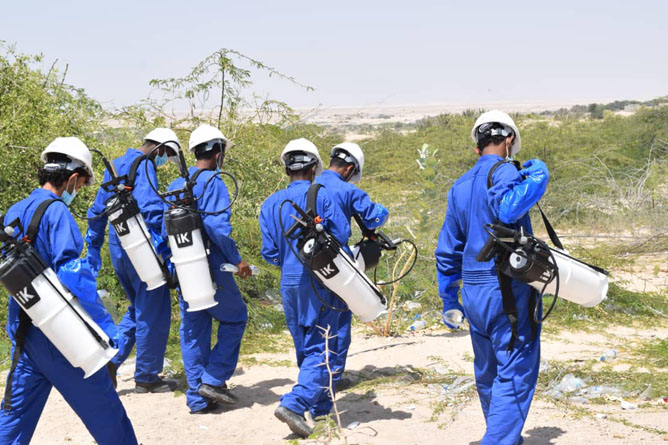
Tools to fight malaria now include breakthrough vaccine
Pesticide spraying in Yemen, as part of a National Malaria Control Programme campaign. Malaria is a life-threatening disease, but it is both preventable and curable. In 2021, WHO recommended a groundbreaking malaria vaccine for children living in high-transmission areas. It is the first vaccine to protect against a parasite and could save tens of thousands of young lives every year.
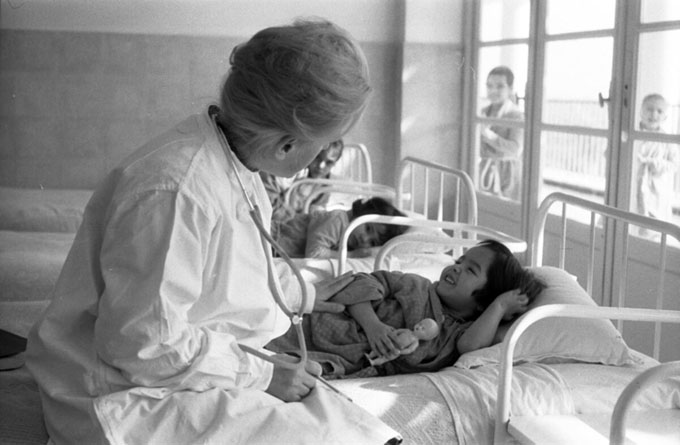
Sustained efforts to cure and control tuberculosis
A child receives care in the children’s tuberculosis (TB) ward of Abderrahmen Mami Hospital, Tunis, Tunisia. WHO and the United Nations Children’s Fund (UNICEF) supported a national antituberculosis campaign in Tunisia until 1961. WHO then helped the government set up a training centre in Tunis, where personnel from across the region learned public health methods for TB control.
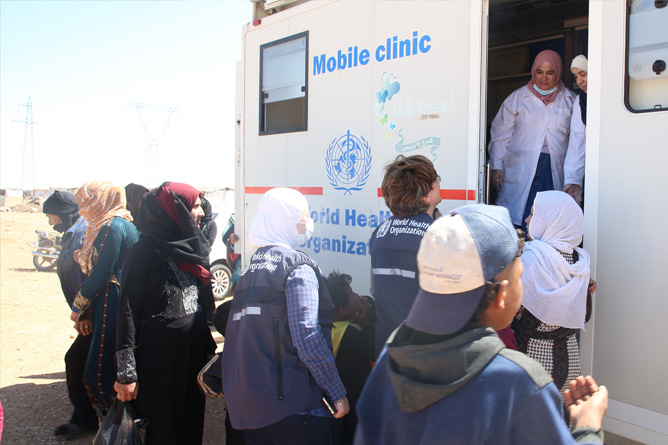
Ending tuberculosis by 2030 remains an urgent goal
A WHO-supported mobile clinic in the Syrian Arab Republic provides free services to people who suspect they have tuberculosis (TB). Caused by a bacterium, TB is spread through the air when an infected person coughs, sneezes, or spits. Global efforts to combat TB have saved an estimated 74 million lives since 2000, but 1.5 million people still die from the disease every year. At its 78th session, the United Nations General Assembly renewed its commitment to end TB.
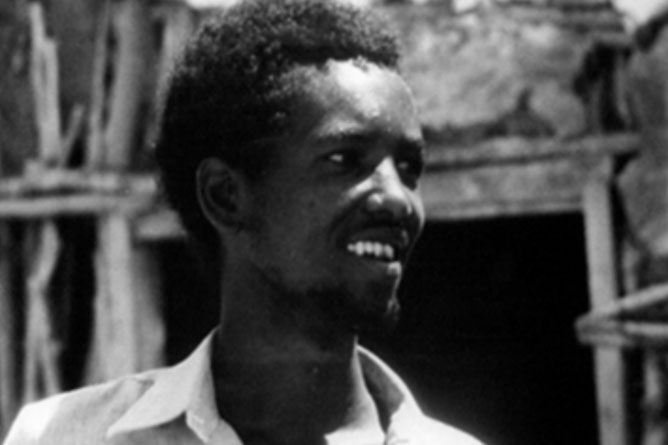
Smallpox is eradicated in 1980
Ali Maow, the last person to be infected with naturally occurring smallpox. Eradicated in 1980, smallpox was one of the most devastating diseases known to humanity. After recovering from the virus, Ali Maow devoted the rest of his life to improving health through vaccination. When he died, in July 2013, he was a serving district polio officer with WHO – part of the global polio eradication effort.
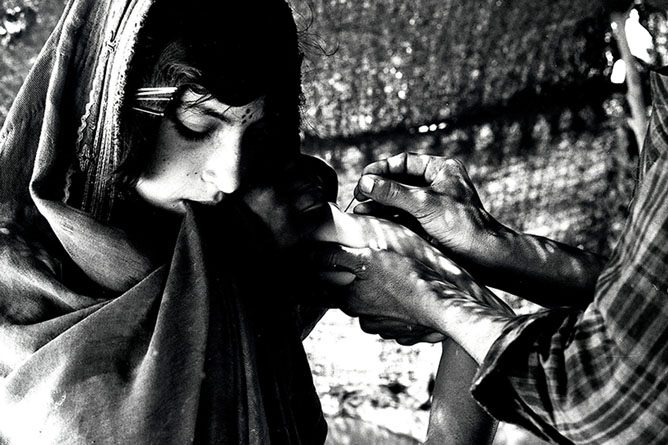
Defeating smallpox after decades of concerted effort
A nomad girl in Afghanistan is vaccinated against smallpox. By 1948, attempts to control smallpox had begun. WHO played a critical role in eradication efforts. In 1980, WHO announced the eradication of smallpox – the only infectious disease in humans to have been eradicated so far. It remains one of the most profound public health successes in history.
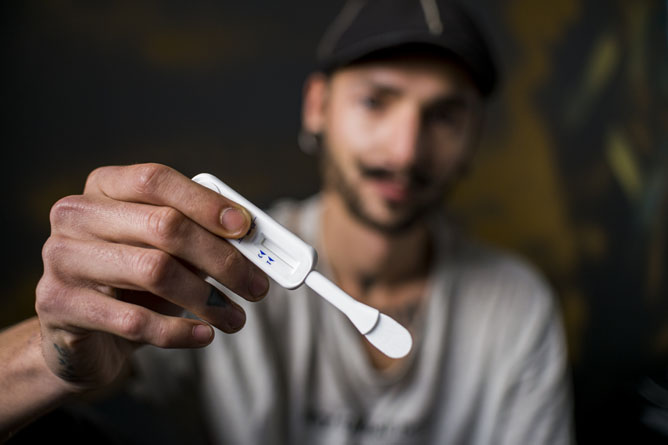
HIV self-testing is recommended by WHO
A man demonstrates an HIV self-test in Bulgaria, where those most vulnerable to HIV infection include gay and bisexual men, men who have sex with men, and transgender people. Many people are unaware of their HIV status. WHO recommends HIV self-testing as a safe, accurate and effective way to reach people who may not otherwise be tested.
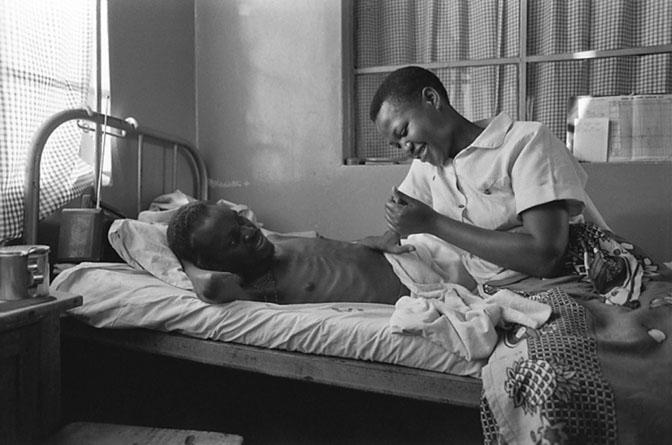
Improving access to antiretroviral therapy for HIV
A woman cares for her partner, hospitalized with AIDS, which is caused by HIV. Having claimed more than 40 million lives, HIV remains a major global public health issue. Lifelong antiretroviral treatment is now offered as soon as possible after diagnosis to manage the illness and prevent transmission. In the Eastern Mediterranean Region, it is estimated that only 38% of all people living with HIV have been diagnosed. Just 27% of people diagnosed with HIV in the Region are on antiretroviral therapy.
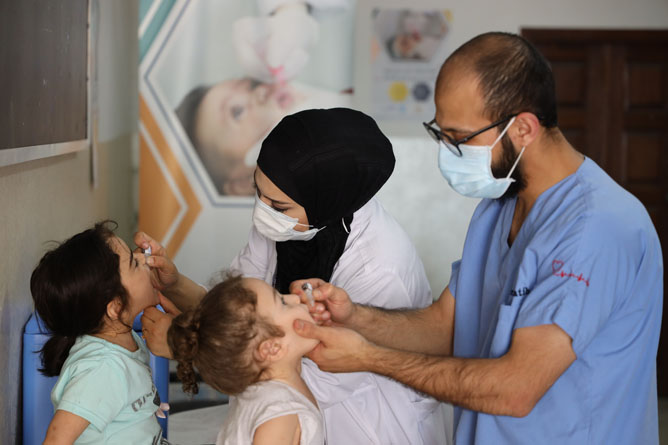
Work continues to protect children against polio
To protect against poliomyelitis, young children receive the bivalent oral polio vaccine at the Al-Ezariyyeh Medical Centre, in the occupied Palestinian territory. Poliomyelitis is a highly infectious disease caused by a virus that invades the nervous system. Polio can cause permanent paralysis or death.
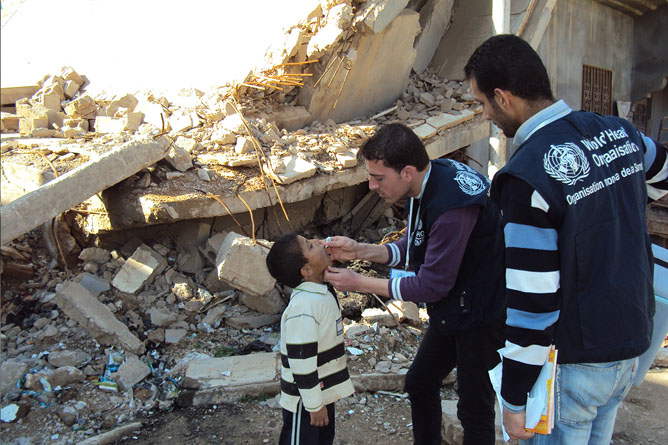
Ending polio is within reach
WHO personnel engage in a WHO-supported polio immunization campaign in Deir ez-Zor, Syrian Arab Republic. Vaccines developed in the 1950s and 1960s paved the way for global campaigns that have led to a 99.9% decline in the number of wild poliovirus cases worldwide.
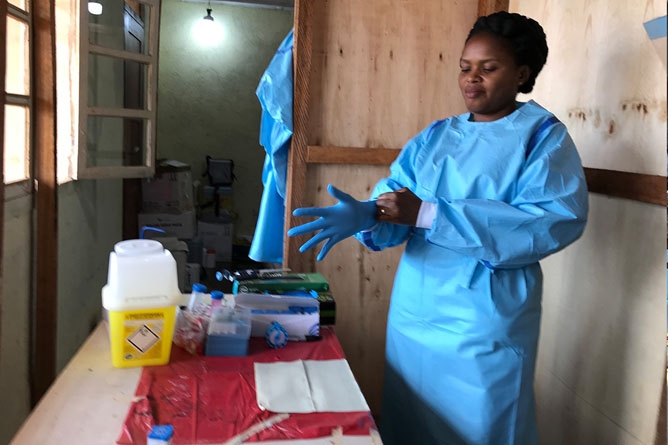
An Ebola vaccine is developed and stockpiled
Ebola sample testing at Beni General Hospital in eastern Democratic Republic of the Congo. The world now has an effective vaccine against one of the major strains of Ebola virus disease. In 2021, a global Ebola vaccine stockpile was established in Switzerland for emergency response to outbreaks.

Emergency response to Ebola outbreak in West Africa
A graveyard in Freetown, Sierra Leone, during the 2014–2016 outbreak of Ebola virus disease in West Africa. Discovered in 1976, the Ebola virus is transmitted to people from wild animals. It then spreads through direct contact with the bodily fluids of infected people. The devastating 2014–2016 outbreak caused over 11 000 deaths and changed how the world responds to health emergencies.
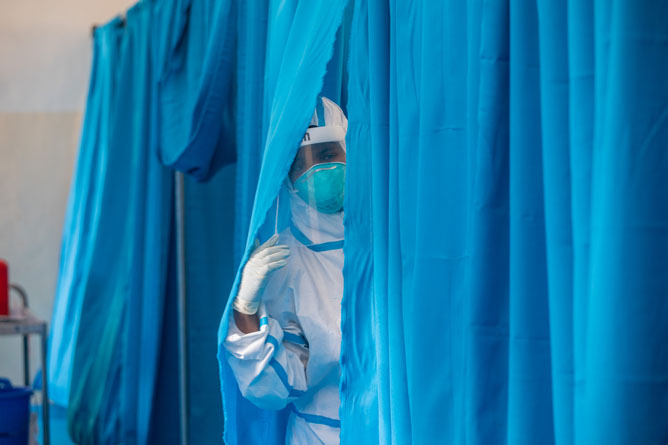
Health workers worldwide confront COVID-19
A health worker in the WHO-supported COVID-19 isolation centre at De Martini Hospital in Banaadir, Somalia. The COVID-19 pandemic has taken a huge toll on the mental and physical health of doctors, nurses and other health workers around the world.
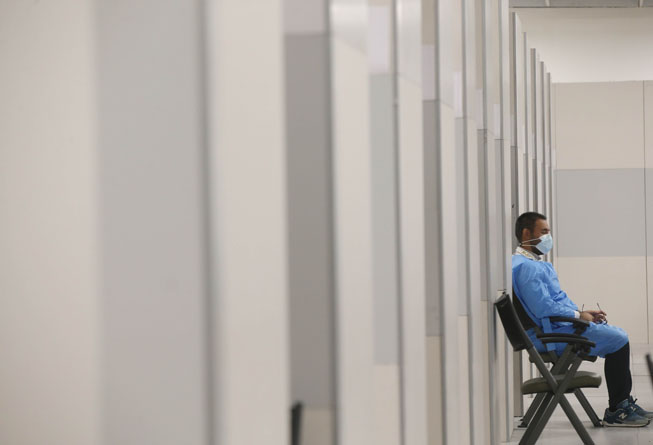
COVID-19 pandemic takes its toll on health workers
A health worker in the Islamic Republic of Iran has a moment to reflect during the COVID-19 response. Health workers across the Eastern Mediterranean Region worked tirelessly to help patients battle this challenging virus. They had to remain apart from their families – isolated and often in mental distress – while risking their lives to protect ours. Health workers were widely recognized as heroes, and many died from COVID-19 while trying to defeat the virus. WHO and health partners are investing in capacity-building of health workers and in preparedness for and response to emerging diseases.
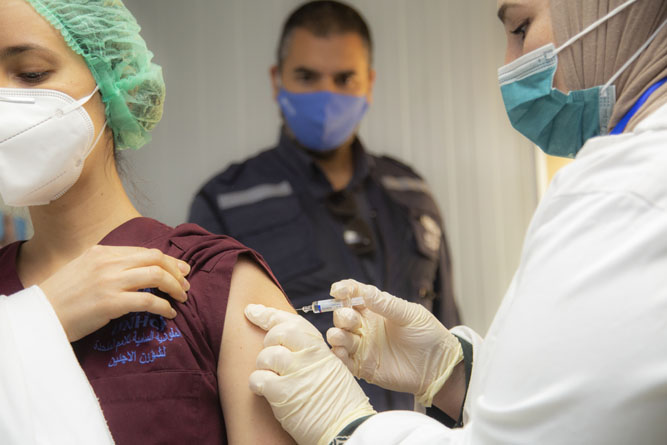
Working for global equitable access to COVID-19 vaccines
A woman is vaccinated against COVID-19 in Jordan. COVID-19 vaccines have saved millions of lives since their introduction, providing strong protection against serious illness, hospitalization, and death. WHO has provided normative guidance on vaccine policy, regulation, safety, and allocation, and country readiness and delivery.
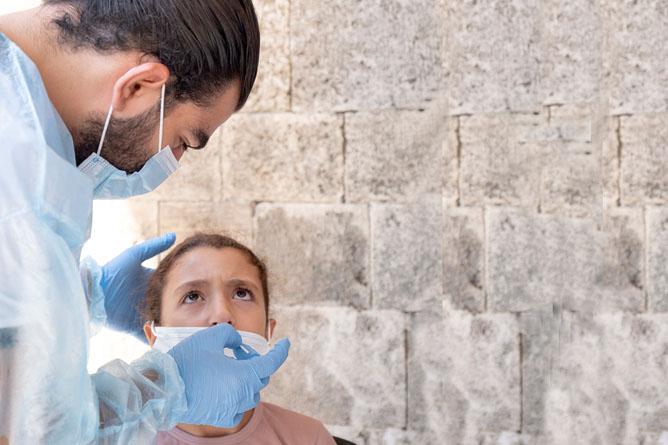
Routine tracking of influenza to inform preparedness
As part of routine influenza surveillance, a health worker in Lebanon collects a respiratory sample from a child. Samples from symptomatic patients are tested at the National Influenza Centre for influenza, SARS-CoV-2, and other respiratory viruses. This routine monitoring informs national, regional, and global actions to prepare for and respond to respiratory viral diseases.
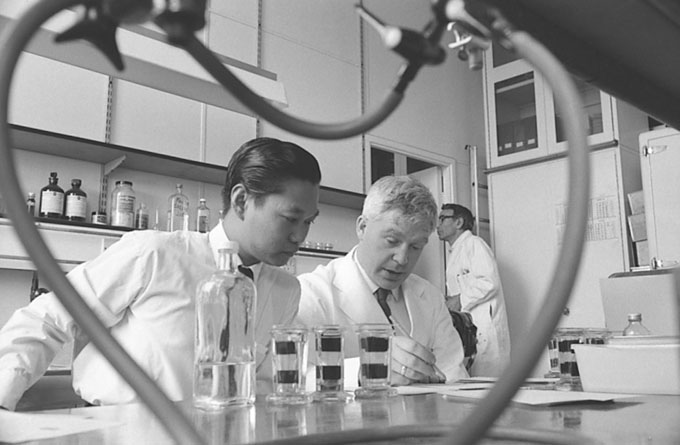
Monitoring influenza globally since 1952
Staff at work in the World Influenza Centre in London, United Kingdom, in 1968. The 1918 influenza pandemic led to as many as 50 million deaths. Every year, influenza still kills up to 650,000 people. Active since 1952, WHO’s Global Influenza Surveillance and Response System monitors respiratory viruses to ensure a rapid response – including vaccine development.
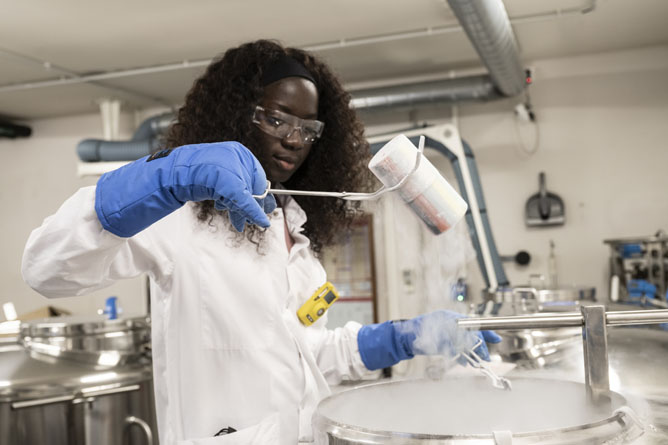
Cancer research that directly informs policy-making
A technician at work in the biobank at WHO’s International Agency for Research on Cancer, Lyon, France. Cancer causes 1 in 6 deaths globally. The Agency promotes research to help determine who develops cancer, what causes it, and how to prevent it. This research has been translated into policies for cancer control – for example, to cut tobacco use and to introduce vaccination against human papillomavirus.
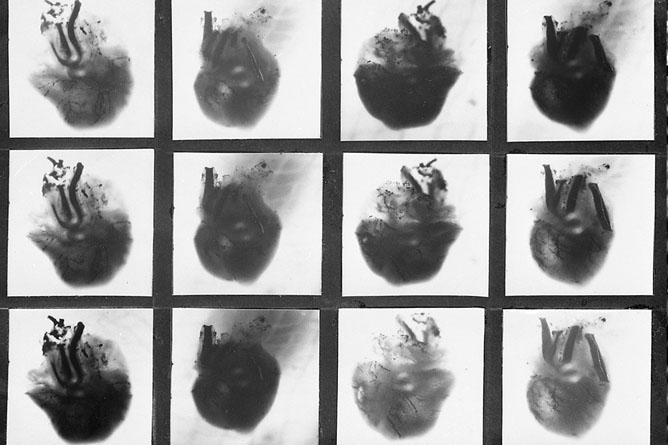
Combating heart disease, the leading cause of death globally
X-ray photographs of a chick embryo’s heart, from WHO research into heart health in 1964. Cardiovascular disease caused 22.5% of all deaths in the Eastern Mediterranean Region in 2019. A surge in cases is linked to risk factors such as unhealthy diet, physical inactivity, and tobacco and alcohol use. In emergency settings, heart attacks and strokes may double or even triple in frequency. WHO has launched the HEARTS initiative to improve cardiovascular health.
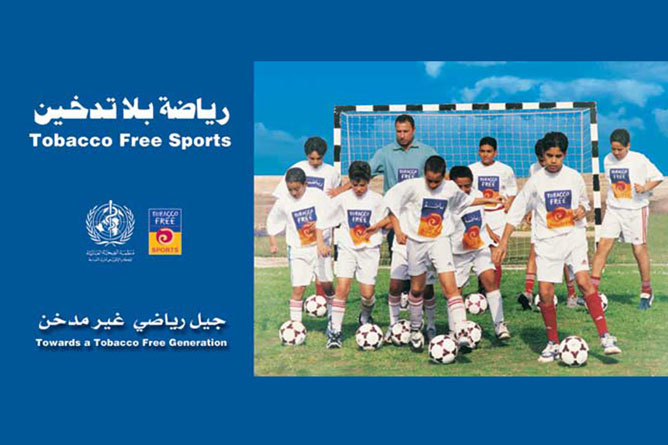
Antismoking champions
WHO urges tobacco control and smoking cessation, including through its “Towards a tobacco-free generation” campaign. There are more than 1.3 billion tobacco users worldwide. Each year, over 8 million people die from tobacco use, while second-hand smoke kills over 1 million more. A ban on tobacco advertising, promotion, and sponsorship can cut tobacco use substantially.
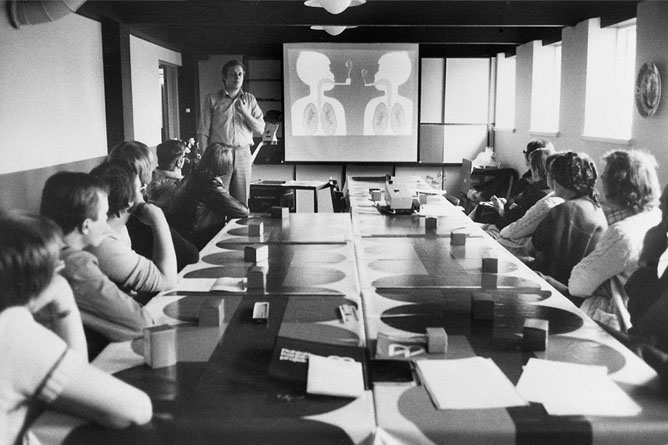
WHO’s first global public health treaty adopted in 2003
An antismoking session for factory workers in North Karelia, Finland, part of a WHO-supported project to reduce cardiovascular disease. Nearly 2 million people die from tobacco-induced heart disease every year. But tobacco users who quit reduce their risk of heart disease by 50% after one year of not smoking. The WHO Framework Convention on Tobacco Control was adopted in 2003.
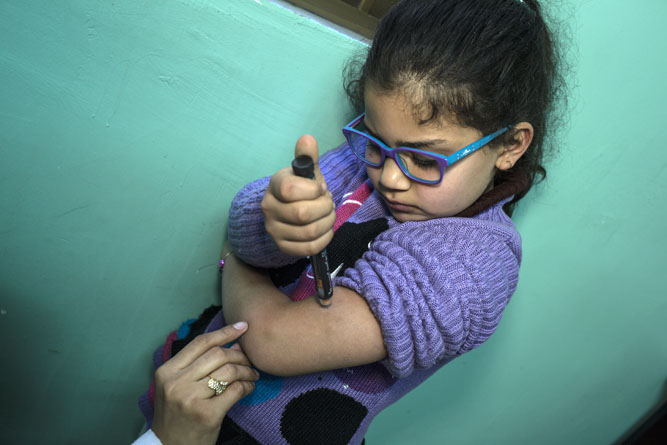
Support to prevent and manage diabetes
A child self-administers an insulin shot at a clinic run by the Jordan Health Aid Society, in Jordan. Patients with or at risk of diabetes can receive a wide array of health services including diagnosis, preventive education, nutrition counseling, and training in insulin administration. Rapid lifestyle changes in the Eastern Mediterranean Region over recent decades have led to soaring rates of diabetes across the Region.
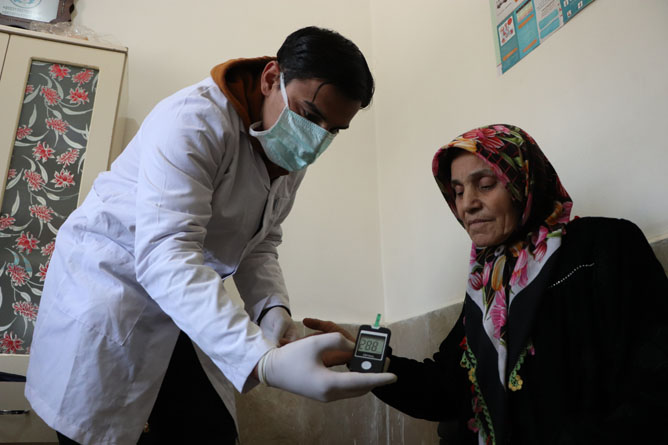
Noncommunicable diseases in emergency settings
A health worker in the Syrian Arab Republic checks the blood sugar of a diabetes patient living in a camp for displaced people. The patient is one of thousands of displaced Syrians who rely on the health center in Zardana, near the border with Türkiye. The center is part of a WHO project on noncommunicable diseases. Its staff are trained to screen for and treat chronic diseases like diabetes.
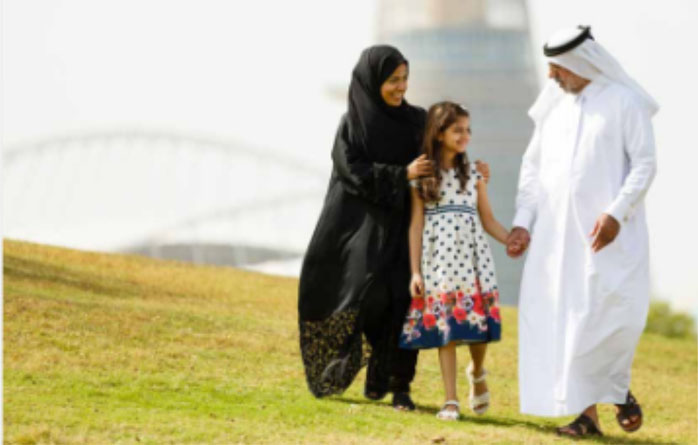
Promoting healthy settings for healthier lifestyles
In 2022, all municipalities in Qatar were recognized by WHO as Healthy Cities. This initiative aims to improve the health of populations through cities that promote health and well-being, improve equity, empower communities, and work to prevent the main causes of ill health. In Healthy Cities, health is an aspect of all policies and drives partnership across all sectors and society.
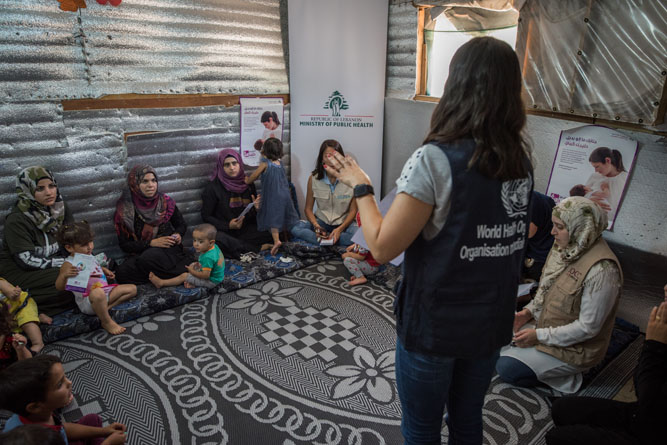
Improving access to safe reproductive health care
In Lebanon, a member of the WHO workforce gives advice on contraceptive use. Unsafe abortion is a preventable cause of maternal death. It can also lead to physical and mental health complications and social and financial burdens for women, communities, and health systems. Lack of access to safe, timely, affordable, and respectful abortion care is a critical public health and human rights issue.
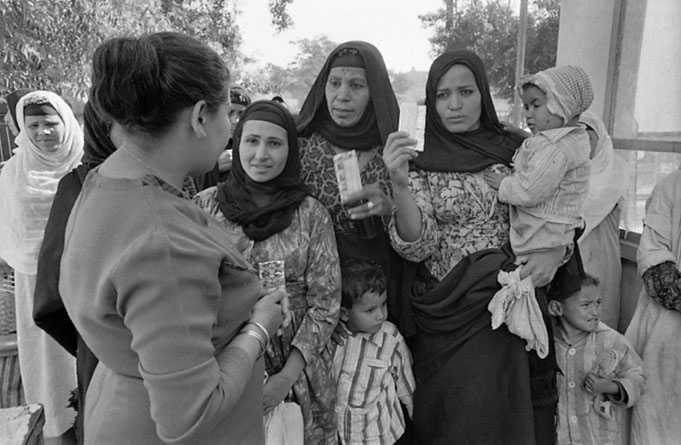
Family planning for better health and prospects
Advice on contraceptive use is given at a family planning center in Egypt, in 1969. Ensuring access for all people to their preferred contraceptive methods has significant health benefits and expands opportunities for women, including access to education and work. Use of contraception prevents pregnancy-related health risks for women, and spacing pregnancies improves child survival rates.
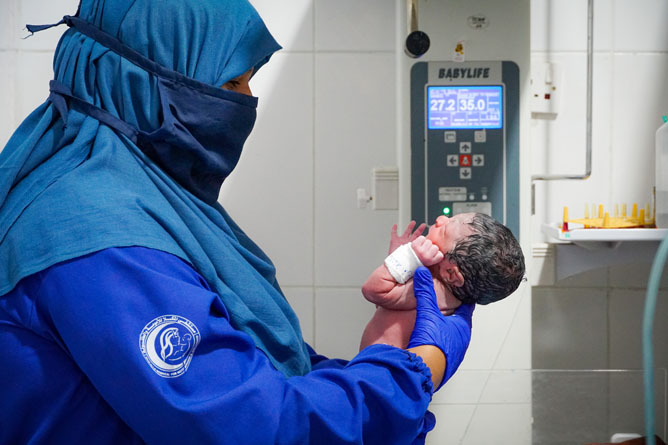
Quality health care for safer childbirth
A healthy baby is delivered at Makla Maternity Hospital in Yemen, which is supported by WHO and United Arab Emirates Aid. Maternal mortality has risen sharply in Yemen, with conflict undermining access to life-saving maternity services. Access to quality health care before, during, and after childbirth is critical to improve health globally and ensure that pregnancy can be a positive experience for all women.
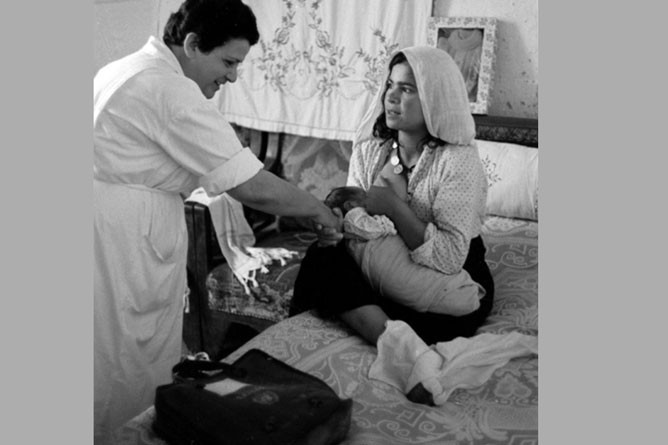
Protecting and promoting breastfeeding
In the 1960s Syria, a mother and her newborn receive a home visit. Breastfeeding is one of the most effective ways to improve child health and survival. Yet it can be seriously undermined by lobbying and marketing by the formula milk industry. To address industry practices that were putting mothers off breastfeeding, WHO Member States endorsed the International Code of Marketing of Breastmilk Substitutes in 1981.
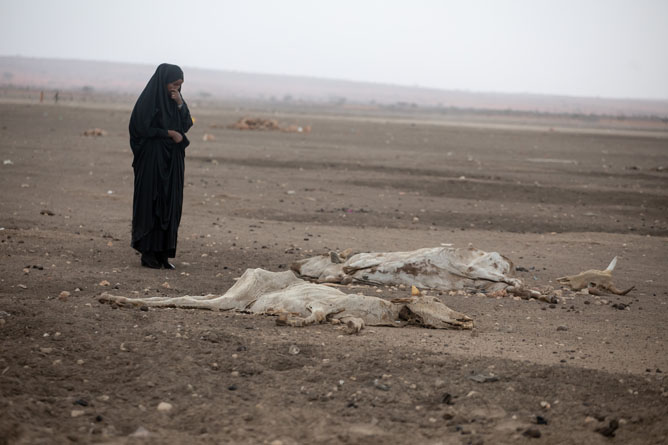
Climate crisis: drought in Somalia
A woman walks past dead cows in Eljale, a village in Somalia. The drought in Somalia and across the Horn of Africa is the worst seen in the Eastern Mediterranean Region in the last four decades and may lead to famine. In Somalia alone, an estimated 6.1 million people have been affected, of whom 759,400 have been displaced in search of water, food, and pasture.
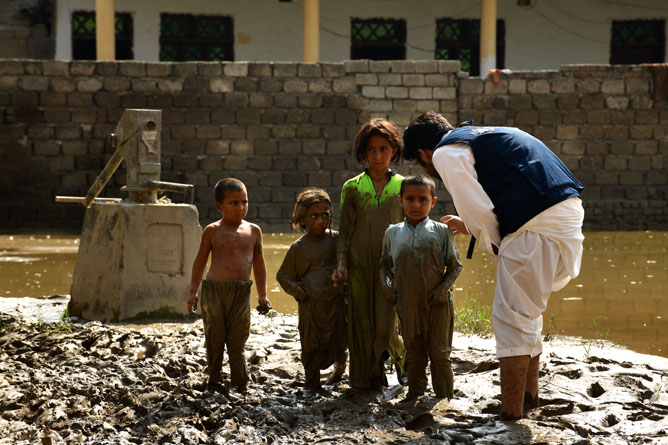
Climate change: Pakistan floods
People affected by the catastrophic floods of 2022, which left 6.4 million people in Pakistan in need of humanitarian assistance. Some 1,400 people were killed, and more than 500,000 homes destroyed and over 660,000 people displaced. Significant damage was caused to 2,000 health facilities, and food supplies were gravely affected by the loss of 3 million acres of crops and over 1.2 million livestock.
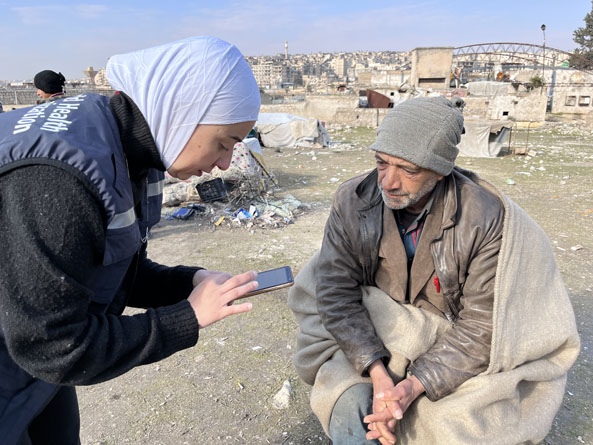
Earthquake disaster in Türkiye and the Syrian Arab Republic
A member of the WHO workforce supports a man in the Syrian Arab Republic displaced by the disaster. On 6 February 2023, a series of large earthquakes hit southern Türkiye and northern Syrian Arab Republic, followed by hundreds of aftershocks. Thousands of lives were lost in the initial earthquakes, and thousands more people were left at risk because of freezing temperatures and the destruction of infrastructure.
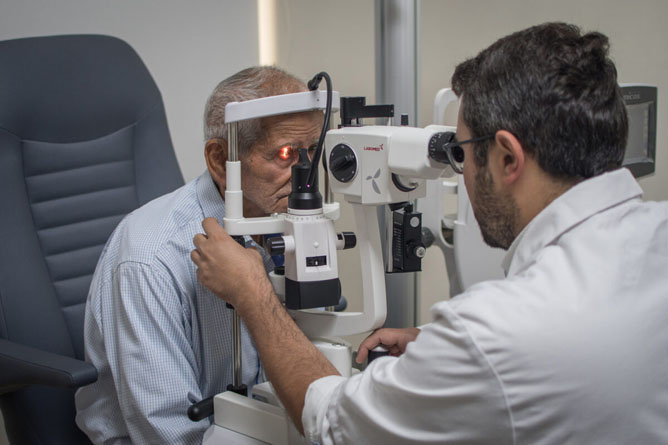
Eye care to prevent vision impairment
An elderly man has his vision checked at a health center in Lebanon. At least 2.2 billion people globally have a vision impairment. It is estimated that almost 12 million people have moderate or severe vision impairment or blindness – due to glaucoma, diabetic retinopathy, and trachoma – that could have been prevented. The global need for eye care is projected to increase dramatically in the coming decades.
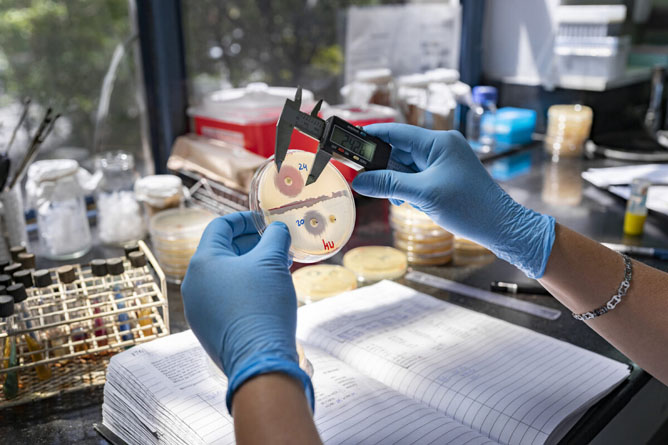
Global action to tackle antimicrobial resistance
A laboratory technician at work in Buenos Aires, Argentina. Antimicrobial resistance occurs when bacteria, viruses, fungi, and parasites change over time and no longer respond to medicines. It makes infections harder to treat and increases the risk of disease spread, severe illness, and death. In 2016, the United Nations General Assembly adopted a political declaration on antimicrobial resistance.
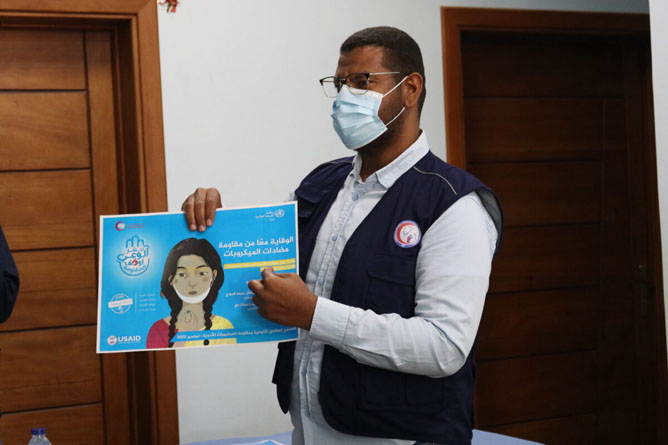
Raising awareness of antimicrobial resistance
During World Antimicrobial Resistance Awareness Week (WAAW) 2022, a community health volunteer shares information at the Karama clinic, Sabha, Libya. WAAW is an annual global campaign that aims to improve awareness of antimicrobial resistance, a major global public health threat, and encourage best practices among the public.
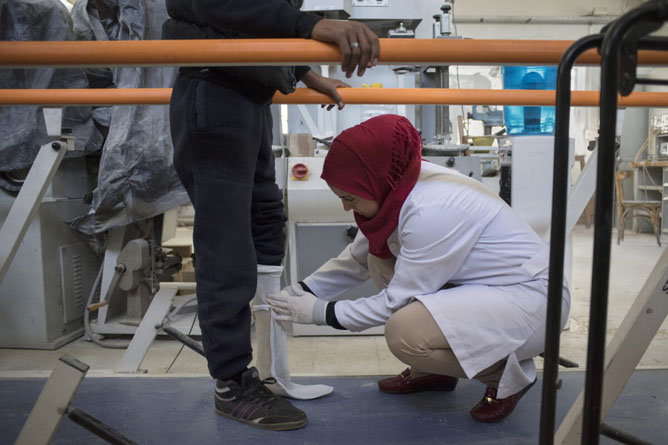
Assistive technology and rehabilitation in action
A health worker at a prosthetics center in Damascus, Syrian Arab Republic, fits a patient with an artificial limb. It is estimated that 1 in 3 people globally live with a health condition that would benefit from rehabilitation. Rehabilitation addresses the impact of a health condition on a person’s daily life and helps the individual to remain as independent as possible.
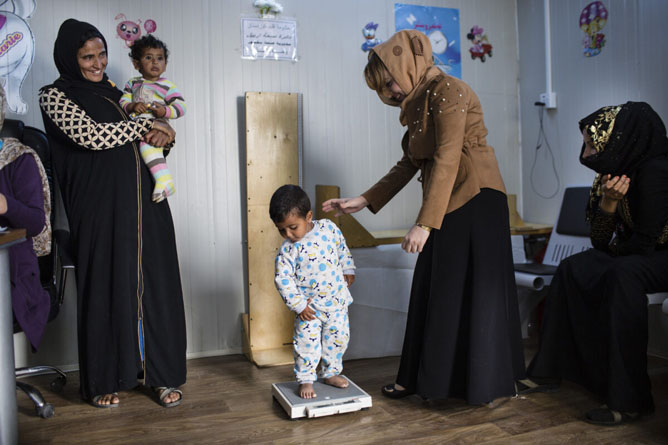
Setting standards for healthy growth
A young boy is weighed at the malnutrition ward in a camp for displaced families in northern Iraq. In 2006, WHO launched the Child Growth Standards, tools to define and measure malnutrition in children under 5 years of age. These are used by governments to establish nutrition targets and by data experts to calculate malnutrition estimates.
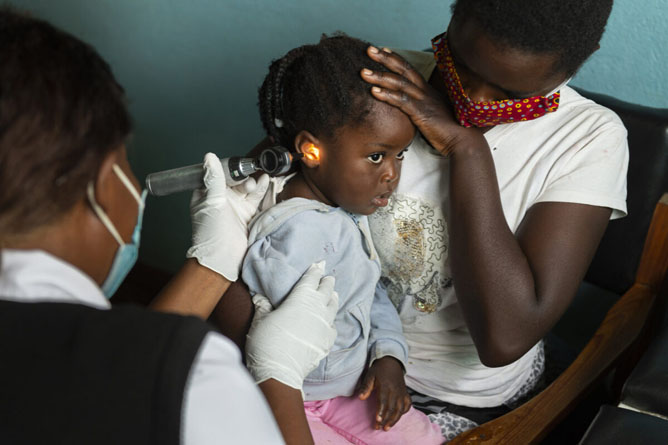
Addressing hearing loss before it causes harm
A nurse treats a young girl for a severe ear infection, which can sometimes lead to hearing loss. If unaddressed, hearing loss may result in delayed language development, academic underachievement, social isolation, cognitive decline, a higher risk of injuries, and increased poverty. One in 5 people worldwide are living with some form of hearing loss.
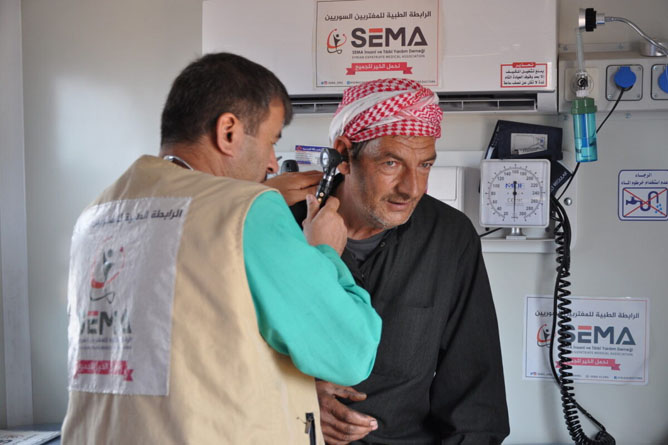
Improving access to ear care globally
A man has his ears examined by a health worker in a mobile clinic deployed to meet the needs of displaced people in north-west Syrian Arab Republic. Twenty per cent of the global population are living with some form of hearing loss. The vast majority live in low- and middle-income countries, where they often lack access to appropriate ear and hearing care services.
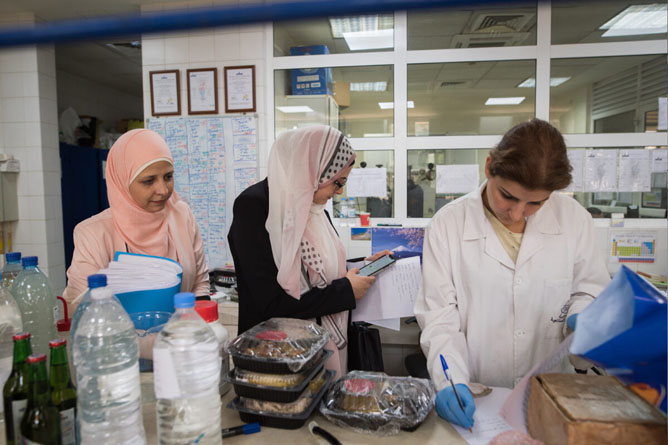
Developing international standards for food safety
Food composition analysis is carried out in Lebanon, including for the 30 most consumed Lebanese dishes in the local diet. WHO provides scientific advice and research to help develop international standards for food safety through the Food and Agriculture Organization of the United Nations and the Codex Alimentarius.
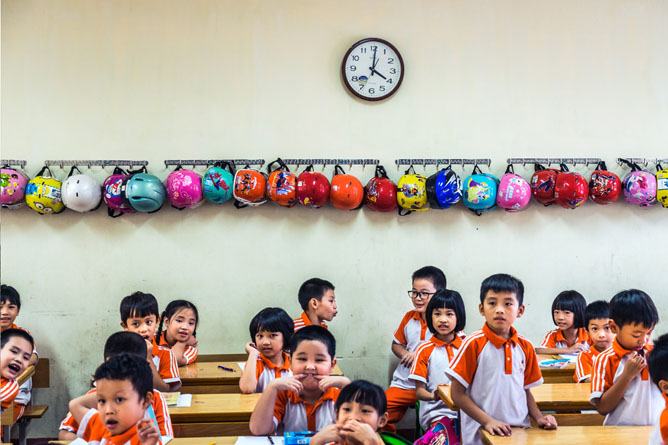
Action to halve road traffic deaths and injuries by 2030
Children sit beneath their helmets hung on a wall of their classroom in Khanh Hoa, Viet Nam. Road traffic injuries are the leading killer of children and young people aged 5–29 years. Measures proven to reduce the risk of road traffic injuries and deaths exist. The United Nations General Assembly has set the target of halving the global number of deaths and injuries from road traffic crashes by 2030.
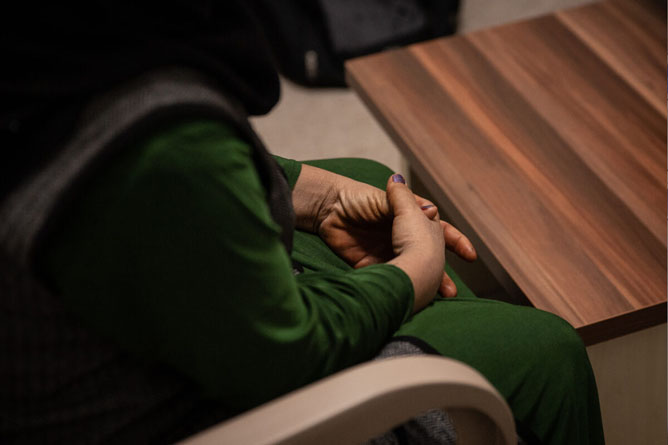
The persistence of violence against women and girls
A beneficiary of the gender-based violence program delivered by Heevie Organization in Debaga camp, Erbil, Iraq. Around the world, violence against women remains devastatingly pervasive. Across their lifetime, 1 in 3 women globally are subjected to physical or sexual violence by an intimate partner or sexual violence from a non-partner. Violence more often affects women living in low-income and lower-middle-income countries.
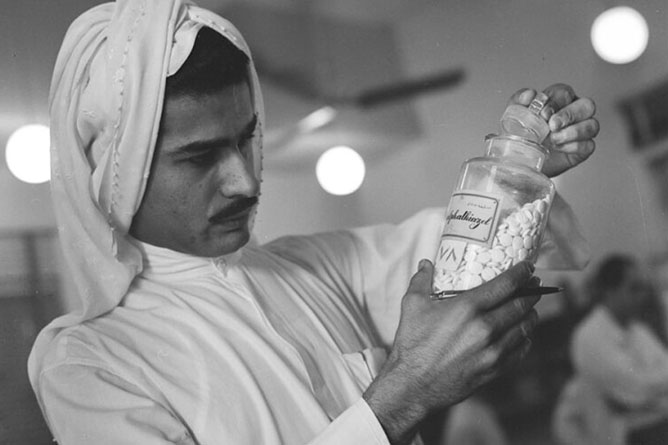
Supporting access to essential medicines
A man inspects a jar of medicine in Kuwait in 1962. WHO’s first Essential Medicines List was published in 1977. The list outlines the medicines that a basic health system needs. Each medicine is selected based on evidence for its safety, effectiveness, and value for money. In 2007, WHO published its first Essential Medicines List for Children.
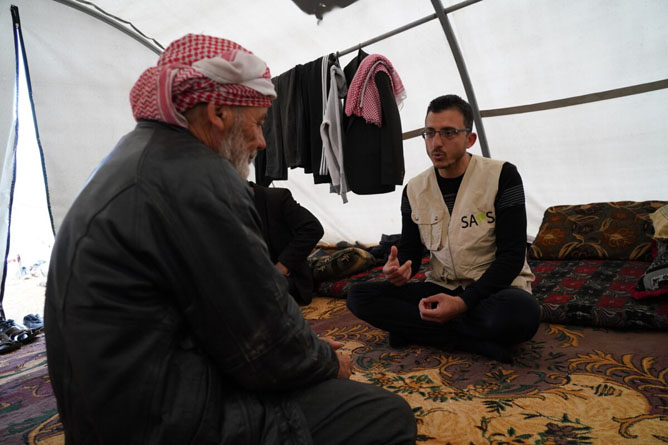
Mental health support in emergency settings
A member of the Syrian Association for Psychological Supporters, a WHO partner, provides psychosocial support following the series of earthquakes that struck Türkiye and the Syrian Arab Republic on 6 February 2023. People affected by such a disaster need psychological support, with pharmacological interventions required in some cases.
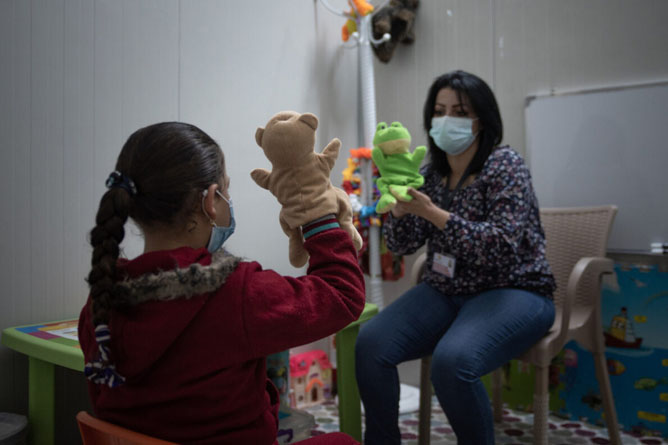
Improving mental health care for all
At Debaga camp in Erbil, Iraq, a psychosocial worker from Heevie Organization plays with a young patient during a social work session. WHO continues its global efforts to reduce stigma and improve mental health support. More than 100 countries have used the WHO Mental Health Gap Action Programme to integrate mental health into primary health care.
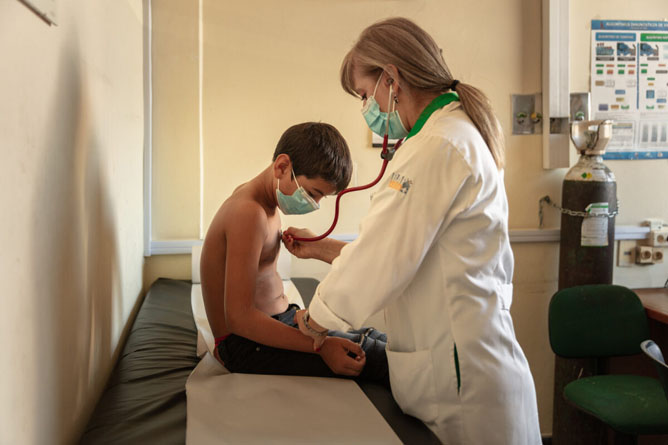
E-waste: the world’s fastest-growing domestic waste stream
High levels of lead were found in this boy’s bloodstream because of exposure to electronic waste. In 2019, 53.6 million tonnes of e-waste were produced – with just 17% recycled appropriately. Lead poisoning poses a serious threat to children’s health. The WHO Initiative on E-waste and Child Health aims to help the health sector better address e-waste exposure.
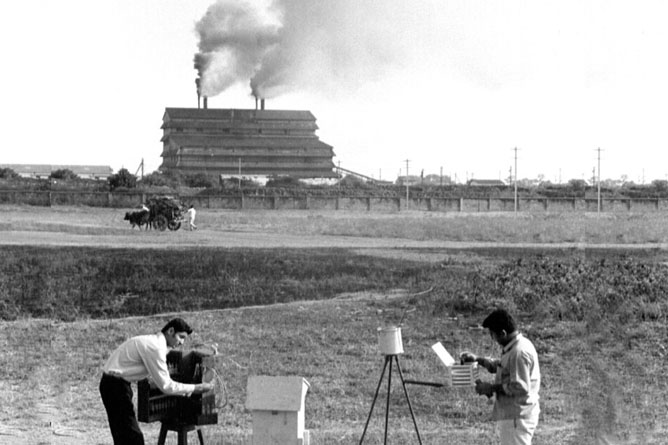
Air pollution disproportionately affects the most vulnerable
Scientists take samples to check air pollution levels in India, in 1970. Today, air pollution is responsible for the deaths of 7 million people worldwide every year. Almost all the global population breathes levels of air pollutants that exceed WHO guideline limits. The most vulnerable populations suffer the highest exposures.
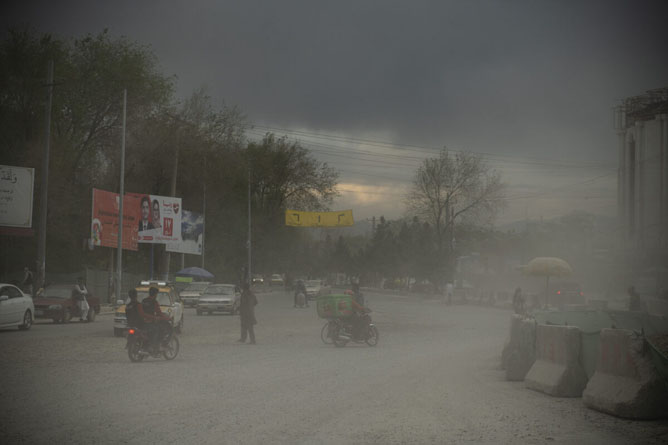
Action on air pollution
Traffic on the streets of Kabul, Afghanistan, on a polluted day. From smog hanging over cities to smoke inside the home, air pollution poses a major threat to health and climate. WHO has developed and implemented a strategy for raising awareness of the risk of air pollution. It has also devised solutions that can be put in place to mitigate the risks of exposure to air pollutants.
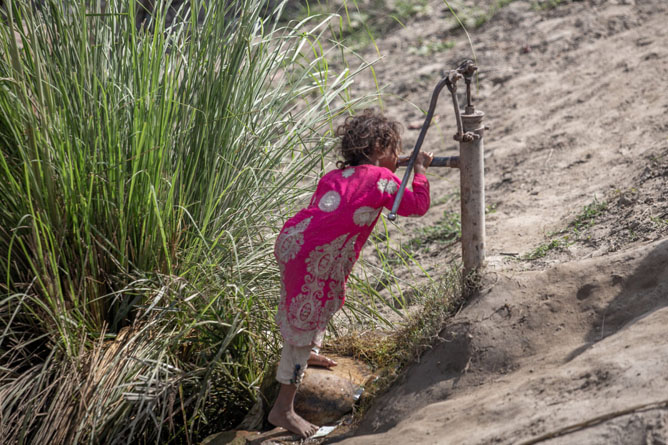
Safe water saves lives
A child drinks from a tapstand in a camp for internally displaced people in Pakistan. Over 2 billion people have gained access to safe drinking water in the past two decades. But at least 2 billion people use a drinking water source contaminated with faeces. Each year, an estimated 829 000 people die from diarrhoeal diseases caused by unsafe drinking water and sanitation and poor hygiene.
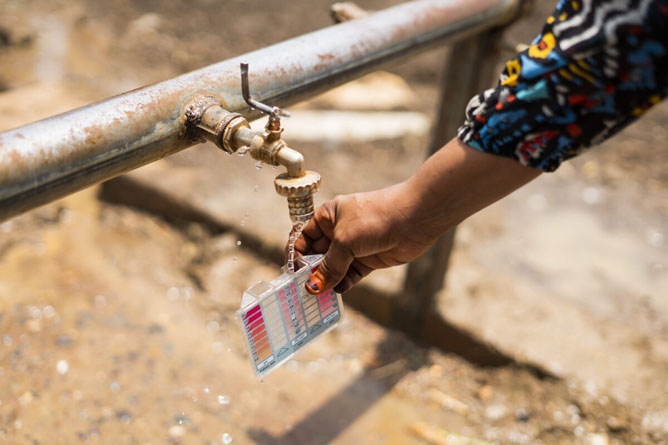
Safe water: a basic requirement for human health
A WHO surveillance officer conducts water quality testing in Um Rakuba camp in eastern Sudan. Safe water, sanitation, and hygiene are fundamental to human health. Improved water supply and sanitation, and better management of water resources, can boost a country’s economic growth and contribute greatly to poverty reduction.
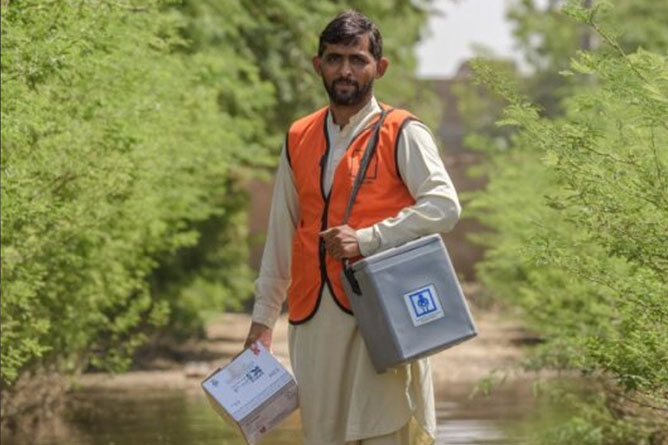
Reaching people in times of crisis
In Pakistan, a health worker wades through water, carrying vaccines, to reach people affected by the devastating floods of 2022. Population movements combined with poor access to vaccination following the floods in September led to a surge in measles cases in the country.
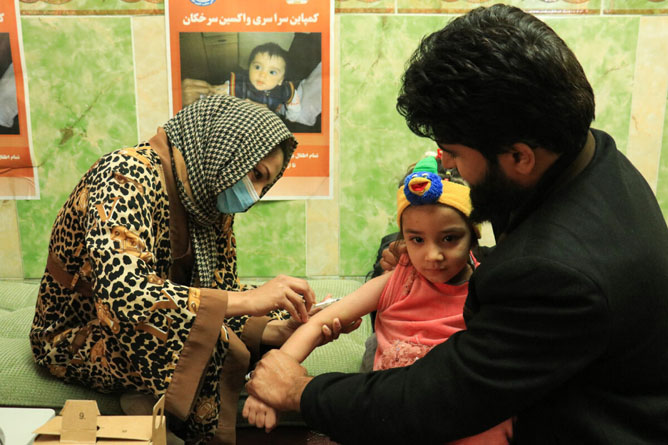
Recovering immunization progress lost to pandemic
A child is vaccinated against measles in Afghanistan. WHO founded the Expanded Programme on Immunization in 1974 to bring life-saving vaccines to all children. Today, vaccines save up to 5 million lives every year by preventing more than 20 diseases. But millions of children have missed out on routine vaccinations amid the COVID-19 pandemic. WHO and partners are now working with countries on “The Big Catch-up”.
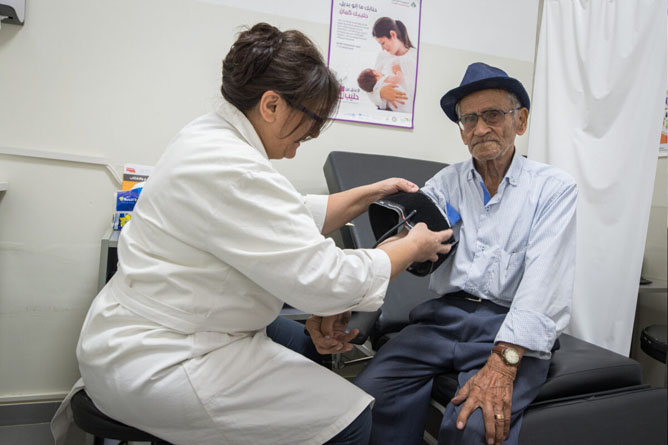
Expanding primary health care
An elderly man has his blood pressure measured by a health worker at a primary health care center in Lebanon. WHO works with countries to provide primary health care services as close as possible to where people live and work. Primary health care is the best way to enhance people’s physical and mental health, as affirmed by the Alma-Ata Declaration of 1978.
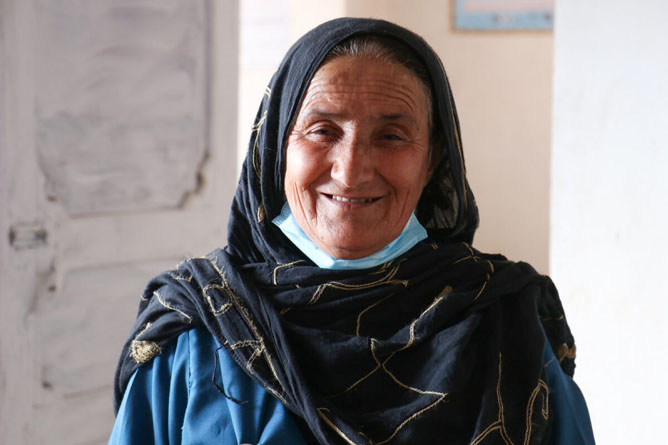
Healthy ageing the whole world over
An older resident of Mangalha village, Afghanistan, at work in a health centre. By 2030, 1 in 6 people globally will be aged 60 years or over. By 2050, two-thirds of the world’s population aged 60 years and above will live in low- and middle-income countries. An ageing population increases demand for primary health care and long-term care as well as age-friendly physical and social environments.
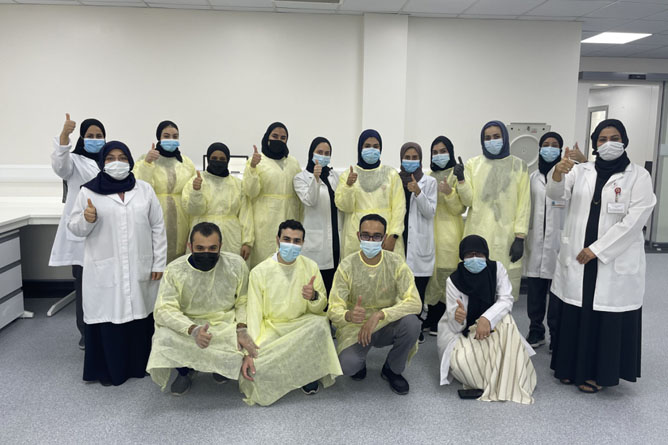
No health without health workers
Today, 7 in 10 health and social care workers around the world are women. A shortfall of some 10 million health workers is projected to occur between 2023 and 2030. Governments must invest in education and decent working conditions and pay to ensure a strong, motivated health workforce. The COVID-19 pandemic highlighted the essential role of health and social care workers in society.
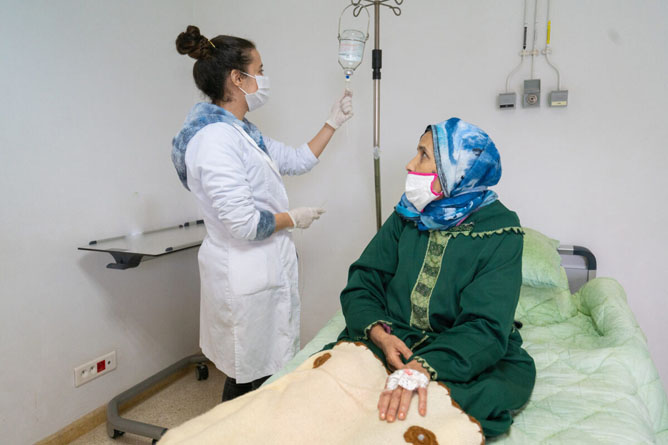
Palliative care for a good death
A woman receives palliative care in a health center in Morocco. Palliative care is a crucial part of integrated, people-centered health services. Relieving serious health-related suffering is a global ethical responsibility, yet it is estimated that only 14% of patients in need of palliative care worldwide receive it. Palliative care must be available at all levels of care.
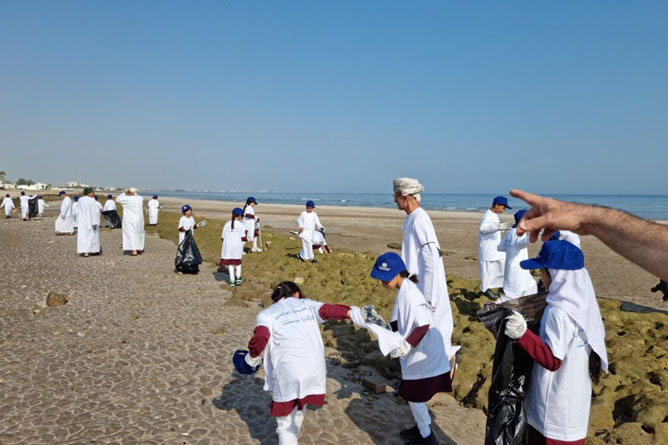
Global inspiration meets grassroots action
In celebration of World Health Day 2022, WHO and Oman’s Ministry of Health organized a beach clean-up event at Azaiba beach, Oman. Local schoolchildren took part in this grassroots action. The clean-up campaign helped the students gain greater awareness of educational, environmental, and health issues, including the need for general and personal hygiene.
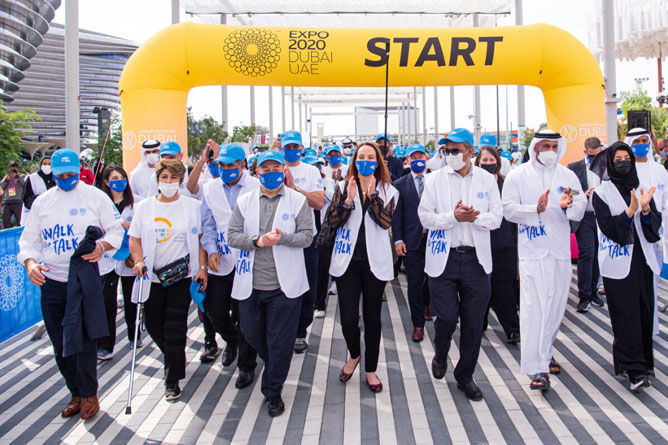
Being more active could avert 5 million deaths a year
A Walk the Talk gets under way at Expo 2020 Dubai, United Arab Emirates. Regular physical activity is proven to help prevent and manage noncommunicable diseases such as heart disease, stroke, diabetes, and several cancers. It also helps to prevent high blood pressure, maintain a healthy body weight, and improve mental health and well-being. An estimated 4–5 million deaths each year could be averted if the global population were more active.
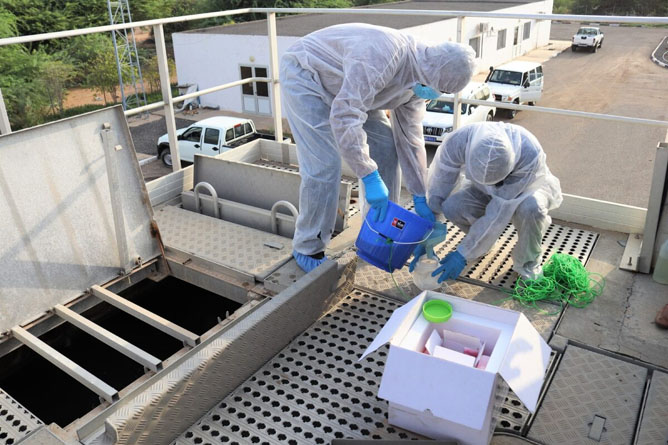
Polio: environmental surveillance expands
A wastewater sample is collected in Djibouti. Regular environmental surveillance allows for the detection of any new emergence or spread of polioviruses – a significant threat until polio is eradicated. In 2020 and 2021, the polio program expanded its environmental surveillance network in the Region, particularly in Afghanistan, Egypt, Somalia, and Sudan. Work also began in Djibouti, Iraq, Saudi Arabia, and Yemen to establish laboratory capacity for environmental surveillance.
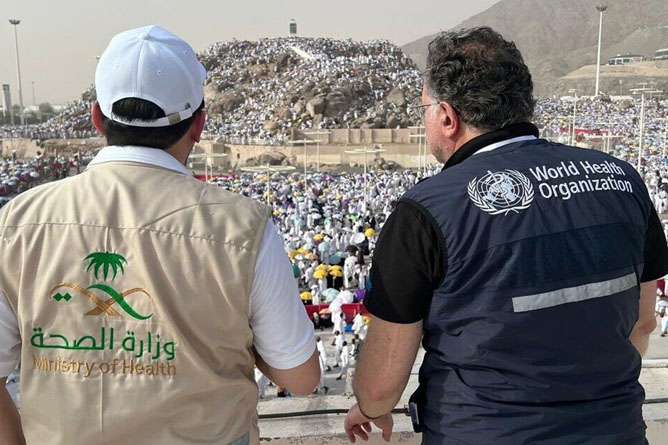
Readiness for mass gatherings
WHO and the Government of Saudi Arabia provide general health advice and guidelines for pilgrims each Hajj season. They work together to ensure that health issues that could arise with any mass gathering of people can be addressed. WHO has developed a list of recommendations for every pilgrim to follow. These are in line with the health requirements set by Saudi Arabia’s health authorities for the Hajj pilgrimage.
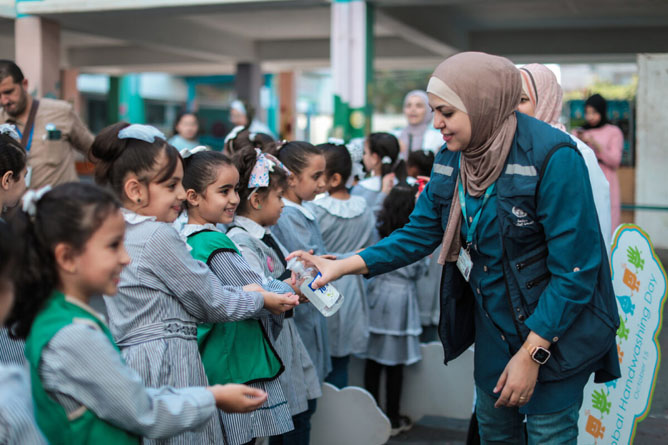
Infection prevention and control begins with hand hygiene
WHO staff teach schoolchildren in the occupied Palestinian territory about hand hygiene, an effective way to prevent the spread of COVID-19 and other infectious diseases. Hand hygiene improvement programs in health care settings can prevent up to 50% of avoidable infections and can generate average economic savings of 16 times the cost of implementation.
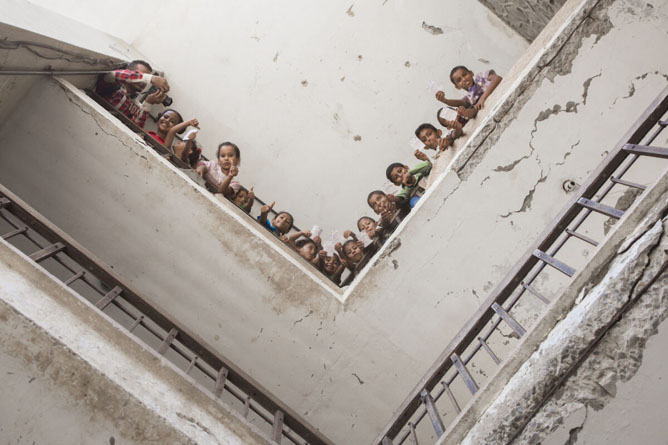
Vaccines work!
In Yemen, children on a balcony show their cholera vaccination cards. Cholera is an acute diarrheal infection caused by ingesting contaminated food or water. WHO considers the current global risk from cholera to be very high and is responding with urgency to reduce deaths and contain outbreaks in countries around the world.
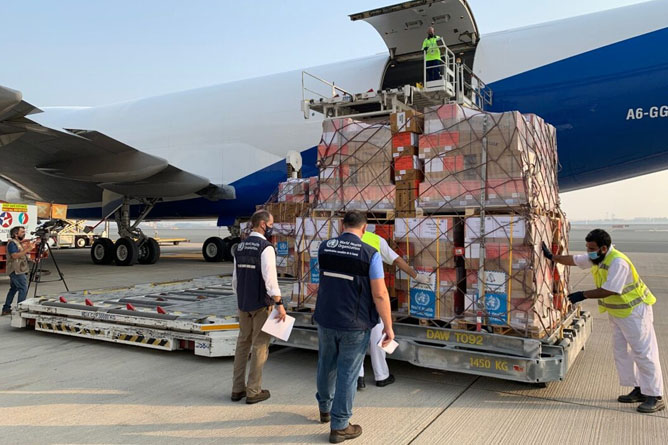
WHO’s logistics hub
The largest single shipment of humanitarian cargo from WHO’s logistics hub in Dubai, United Arab Emirates, is prepared for airlift to Ethiopia. The logistics hub represents the largest repository of pre-positioned health supplies and equipment within WHO’s global supply chain. The operation rapidly delivers essential medicines and equipment in response to acute and protracted health emergencies around the world. It sends health supplies to over 141 countries across all 6 WHO geographic regions.
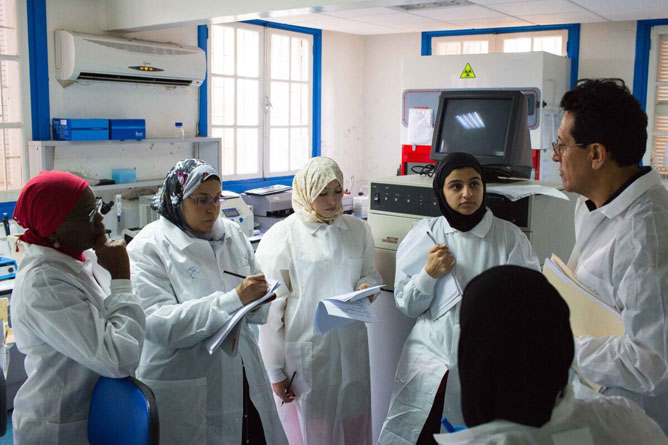
Influenza pandemic preparedness
Health workers are trained in influenza preparedness in a laboratory setting in Rabat, Morocco. WHO is supporting governments in the Eastern Mediterranean Region to prepare for future pandemics through a whole-of-society approach. This includes ensuring strong capacity for early warning systems and epidemiological surveillance, laboratories, health systems and health professionals, the emergency response system and risk communications.
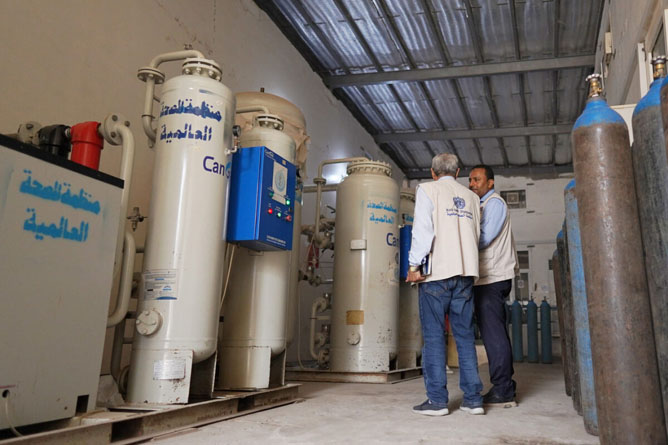
Life-saving supplies in emergency settings
An oxygen station is installed at Al-Thawra Hospital in Sana’a, Yemen. WHO, working with health partners, provides sustainable life-saving medical oxygen for millions of people in Yemen. During the first half of 2022 alone, the hospitals where the oxygen stations were installed provided medical services for almost 400 000 patients, supporting an estimated 9000 major surgeries and 121 000 deliveries.
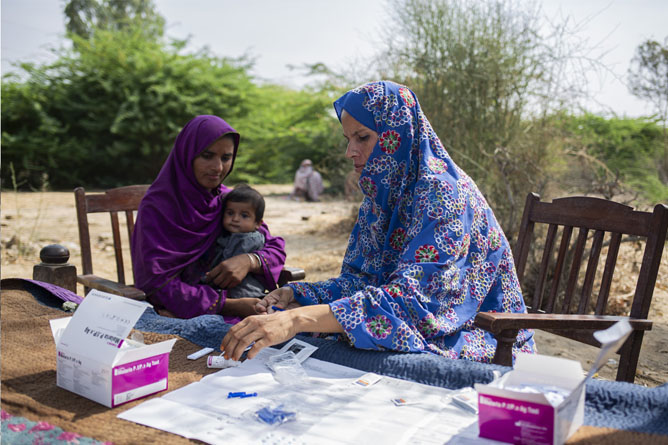
Towards universal health coverage
A community health worker in Pakistan provides care in coordination with a primary health care (PHC) facility. WHO is piloting a project to reorient health systems towards PHC in 3 countries of the Eastern Mediterranean Region. Working with countries to achieve universal health coverage is at the heart of WHO’s mission. The goal is for all people to have access to the full range of quality health services they need, when and where they need them, without financial hardship.

Climate change: deadly floods
A car washed up on the shore by the catastrophic floods that struck Libya in September 2023, following Storm Daniel. Thousands of people have been reported dead and thousands more are missing. The collapse of 2 dams above Derna led to a deluge of water that leveled buildings, swept away entire families, and displaced about 40 000–45 000 people. WHO is working closely with the local health authorities to reach the affected population, restore health services, and reinforce disease surveillance.
Contact us

معلومات عامة
للحصول على معلومات حول هويتنا وعملنا ومكان عملنا، يرجى زيارة صفحة معلومات عن المنظمة.
وللحصول على معلومات حول المسائل المتعلقة بالصحة، يرجى زيارة قسم المواضيع الطبيةعلى موقعنا الإلكتروني.
ولمعرفة المزيد عن أنشطتنا على المستوى القُطري في إقليم شرق المتوسط، يُرجى زيارة الصفحات القُطرية.
المنشورات
للاطلاع على معلومات عن آخر منشوراتنا، يُرجى زيارة بوابة المنشورات على موقعنا الإلكتروني. ويمكنك مراسلة فريق المنشورات عبر البريد الإلكتروني لطلب المزيد من المعلومات عن منشوراتنا من خلال عنوان البريد الإلكتروني التالي:
التوظيف
لمعرفة فرص العمل في منظمة الصحة العالمية، راجع صفحة التوظيف. كما يمكنك التقدم بطلبات للوظائف المُعلن عنها من خلال صفحة البحث عن وظيفة.
الاستفسارات الإعلامية
لمتابعة آخر أخبارنا الإقليمية، يُرجى زيارة المركز الإعلامي على موقعنا الإلكتروني.
وللاستفسارات الإعلامية، يُرجى مراسلة فريقنا الإعلامي على البريد الإلكتروني التالي:
منظمة الصحة العالمية
المكتب الإقليمي لشرق المتوسط
شارع منظمة الصحة العالمية (امتداد عبد الرزاق السنهوري)
ص ب 7608
مدينة نصر
القاهرة 11371
مصر
الهاتف: (+20) 2 22765000
الفاكس: (+20) 2 23492092/23492075










